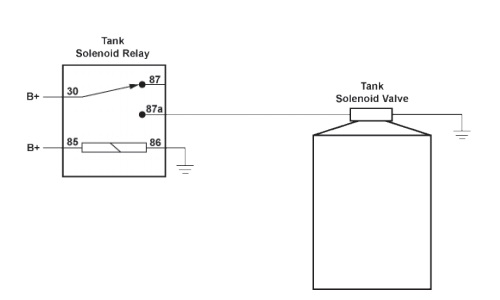FREE CNG Engines and Fuels Questions and Answers
How can a vehicle equipped with a compressed natural gas system be identified?
Explanation:
Vehicles equipped with Compressed Natural Gas (CNG) systems are often marked by an NGV (Natural Gas Vehicle) sign. This sign helps easily identify vehicles that use natural gas as fuel.
There is a no-start condition in the dedicated CNG vehicle. The following could be the cause, except _______________.
Explanation:
While the other options could potentially cause a no-start condition, recurved timing typically wouldn't directly lead to such an issue. Timing adjustment usually affects engine performance but doesn't directly prevent the engine from starting.
Normally, the tank shown in the picture below has a closed solenoid valve. What must be done to allow the cylinder to be vented?

Explanation:
Remove the relay and install a jumper wire across terminals 30 and 87 to allow the cylinder to be vented.
What should a technician do if stress corrosion cracking is evident in a hoop-wrapped Type-2 cylinder?
Explanation:
Remove the cylinder from service. Stress corrosion cracking poses a significant safety risk, so it's essential to take immediate action to prevent any potential hazards.
What is the natural gas vehicle (NGV) engine regulator used for?
Explanation:
The NGV engine regulator is responsible for regulating the pressure of natural gas from the tank before it enters the engine. This ensures that the gas is delivered at the appropriate pressure for efficient combustion in the engine.
When checking the fuel line connections after a compressed natural gas conversion, which of these should be used?
Explanation:
Non-ammonia soap is commonly used to check fuel line connections after a compressed natural gas conversion because it can help detect leaks by producing bubbles when applied to the connections. Nitrogen, propane, and carbon dioxide are not typically used for this purpose.
After three hours, a 350-mile typical range CNG transit bus stops running. 375 psi is displayed on the high-pressure fuel gauge. The following can be the cause, except_____________.
Explanation:
If the high-pressure fuel gauge shows 375 psi, it suggests that the high-pressure regulator is functioning properly, as it's maintaining pressure within the expected range. Therefore, the correct answer is: defective high-pressure regulator.
The technician finds that the vehicle won't take fuel after replacing the CNG fuel tank. Which one of these might be the reason?
Explanation:
If the manual lock-down valves are not opened properly after installing a new CNG fuel tank, it can prevent the vehicle from accepting fuel.
What is the compress natural gas engine mixer used for?
Explanation:
The mixer in a compressed natural gas (CNG) engine blends air and gas before entering the intake manifold of the engine. This mixture is essential for proper combustion within the engine.
What must be done first to repair an EPA-certified CNG system that has failed emissions due to a failure of an expensive system component?
Explanation:
When an EPA-certified CNG system fails due to a high-cost component, the first step should be to check with the system manufacturer for warranty coverage. This ensures that the repair is conducted according to manufacturer specifications and may provide cost-saving options for the customer.
A transit bus's engine compartment makes a puffing noise during operation. Which one of the following might be the cause?
Explanation:
When an exhaust manifold gasket is leaking, it can cause a puffing noise from the engine compartment due to the escaping exhaust gases.